In mid-October I returned to the Southern Ocean for a special extended trip to South Georgia. If you were to ask several seasoned, wildlife photo pros to name their favorite wildlife destination on our planet, chances are that a large number would have South Georgia at the top of their list. The extreme remoteness of its location means that it receives few visitors each year and save for a handful of British Antarctic Survey staff, it is uninhabited. As a result it remains in pristine condition, teeming with an extraordinary collection of wildlife and containing, amongst others, the world’s largest colonies of King Penguins and Elephant Seals, all set against a majestic backdrop of tumbling glaciers and snowcapped mountains. In many other wildlife destinations that I have journeyed to, large amounts of patience are required as you wait for the wildlife to actually do something. In South Georgia, the opposite is true. Indeed, one is often surrounded by so much wildlife and activity that it can be overwhelming at times. On some sites, the density of wildlife is so great that photography actually becomes quite challenging – framing and composing become difficult and you end up having to work hard to find clean lines and separation between the birds and animals. No one however, leaves South Georgia disappointed and it remains one of those rare locations where wildlife numbers are actually increasing. The contrast between my home in Asia, where almost every species is in decline, couldn’t be greater.
As usual, I kept no diary or even notes from the trip but I took plenty of photographic images, processing and labeling many along the way. Most non serious photographers take pictures in large because by freezing a moment in time, they help preserve memories and this is probably the most compelling feature of photography. I certainly don’t have the greatest powers of recollection but I would estimate that nearly 100% of the time, I could look at any of the decent image that I have taken over the last 10-12 years and instantly tell you when and where it was taken and most importantly, the story behind the image. So for me as well, viewing my own images helps to bring back memories and since I’m pretty much always a happy camper when I’m out photographing, even in climatic extremes, these memories almost always tend to be good ones.
After arriving in Santiago, Chile via Auckland, New Zealand (journey time from Hong Kong including seven hours at Auckland airport = 35 hours), I was fortunate to be able to join celebrated bird photographer and hands down the world’s best photographic teacher, Arthur Morris (www.birdsasart.com) for a morning of photography, an hour from Santiago near the coastal town of Vina Del Mar. Also joining us were super creative pro photographer, Denise Ippolito (www.densieippolito.com) and mega talented photographer, Clemens Vanderwerf (www.clemensvanderwerf.com). We were very generously hosted by Chile’s finest bird photographer, Osvaldo Larrain (www.osvaldolarrain.com).
Despite the dreary weather, we had good opportunities with Sea Lions, Pelicans and Aztec Terns.

Sea Lion in surf, Vina Del Mar, Chile, Canon 1D MK4, Canon 600mm IS 2 lens, Gitzo tripod, 1/1,000th sec, f5, ISO 1,250, manual exposure
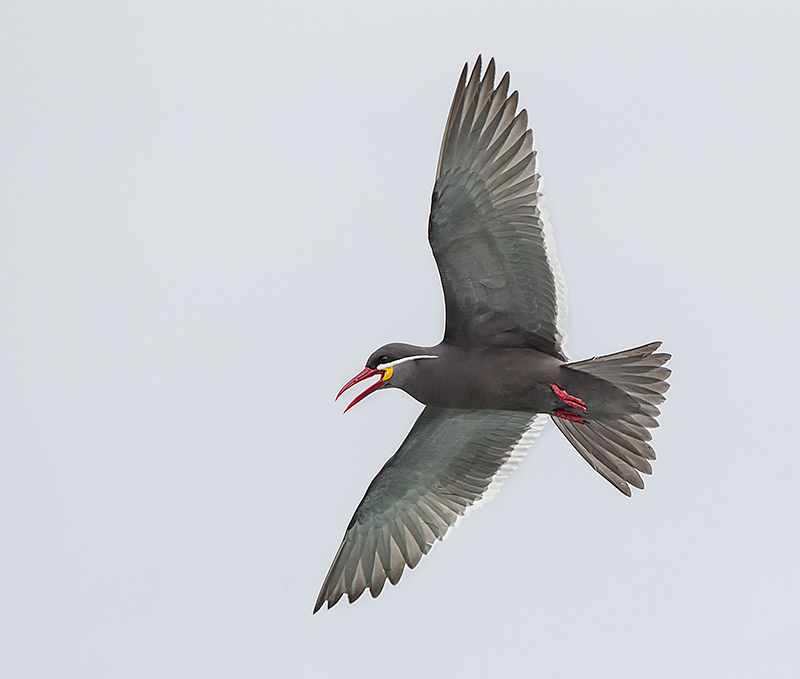
Aztec Tern in flight, Vina Del Mar, Chile, Canon 1D MK4, Canon 600mm f4 IS 2 lens, handheld, 1/ 2,000 sec, f5.6, ISO 800, manual exposure
The next day we flew to the Falkland Islands where we boarded our ship for the four day voyage to South Georgia. As usual at these latitudes, the ship was followed by a constant procession of seabirds, including a number of Albatross and Petrel species. While it is relatively easy to take fast shutter speed images of the birds in flight behind and alongside the ship, I set myself the task of improving on the slow shutter speed images that I made last year, concentrating on the swift and erratically flying Cape Petrels. After hundreds of efforts, I eventually produced this image, one of my all-time avian image favorites, with the feather details bought to life by the use of rear curtain sync, fill flash.
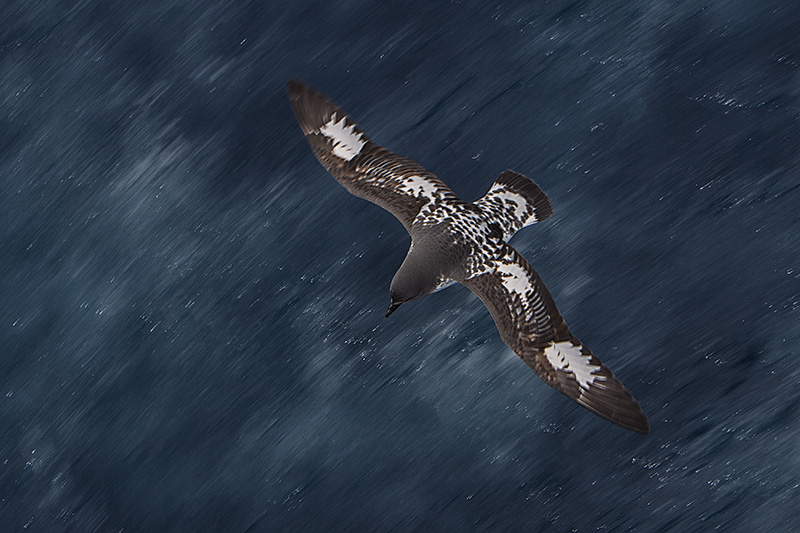
Cape Petrel flying over ocean surface, with motion, Scotia Sea, Southern Ocean, Canon 1D MK4, Canon 70-200mm f2.8 lens at 98mm, handheld, 1/80th sec, f.13, ISO 50, manual exposure, Canon 580 EX flash at -1
At midday on our fourth day at sea, the distant outline of the north east shore of South Georgia began to take shape through the mist. By mid-afternoon we were in the zodiacs headed for shore at Elsehul. This is a site that is usually inaccessible due to hyper aggressive Fur Seals but being extremely early in the season, they were not so territorial and we were afforded a safe passage across the beach. After a short but difficult climb up through uneven tussock grass and mud covered terrain, we emerged onto the edge of steep cliffs below which nested Grey-Headed and Light Mantled Sooty Albatrosses. It was difficult to get decent images of the nesting birds as you were generally shooting straight down on them meaning that the best opportunities were of the birds in flight. I wish I had done better with the Grey-Heads as they are a phenomenally beautiful bird with their yellow and red bills.

Light Mantled Sooty Albatross flying over bay lined with snow dusted mountains, Elsehul, South Georgia, Cnon 5D MK3, Canon 24-105mm f4 IS lens @28mm, handheld, 1/800th sec, f9, ISO 640, manual exposure
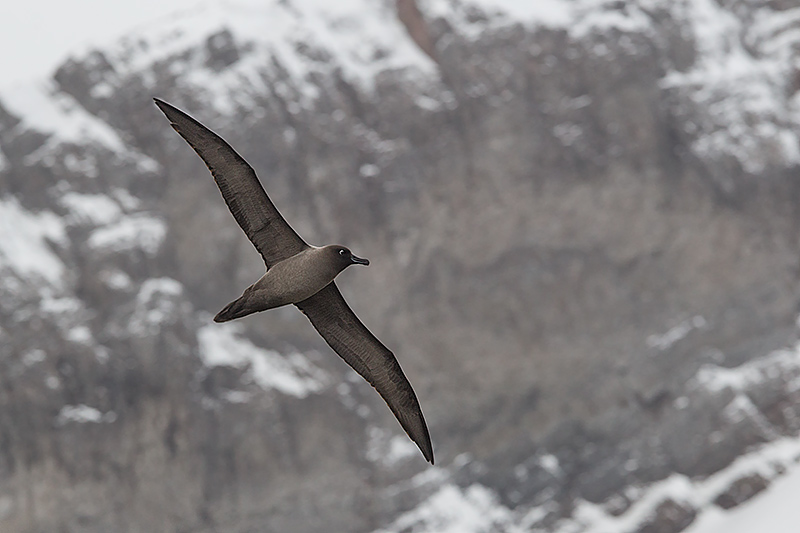
Light Mantled Sooty Albatross flying past snow covered mountains, Elsehul, South Georgia, Canon 1D MK4, Canon 300mm f2.8 IS lens, handheld, 1/800th sec, f5.6, ISO 1250, manual exposure
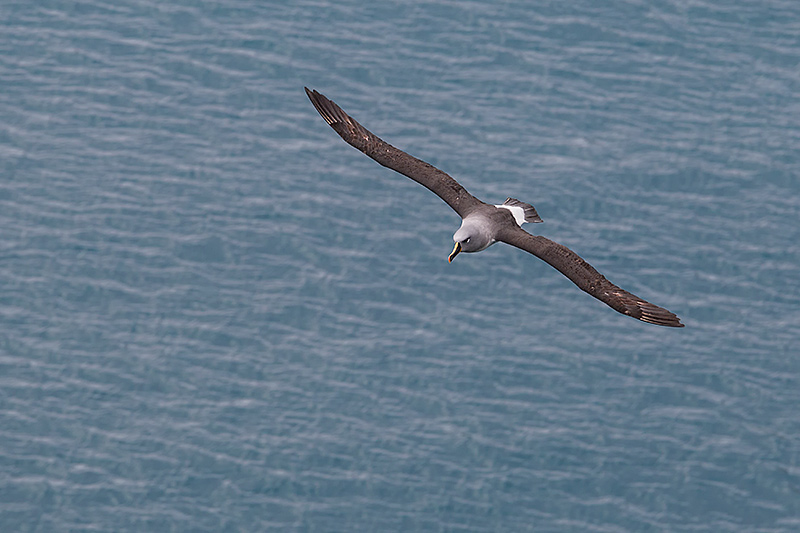
Grey Headed Albatross flying over sea, Elsehul, South Georgia, Canon 1D MK4, Canon 300mm f2.8 IS lens, handheld, 1,000th sec, f5.6, ISO 640, manual exposure
Close to the landing site at the top of the beach, resided a large colony of Gentoo Penguins, many of whom were sitting on eggs. Those that were not, were largely engaged in nest building activities. From time to time, the Gentoos would throw back their heads and call loudly to their partners.
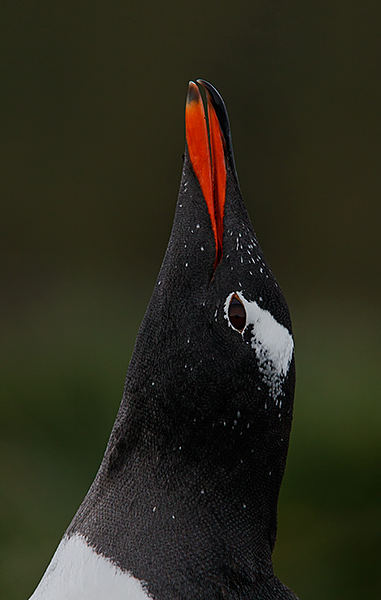
Gentoo Penguin with head and bill thrust into the air, Elsehul, South Georgia, Canon 1D MK4, Canon 300mm f2.8 IS lens + 1.3x TC, handheld ,1/320th sec, f8, ISO 1000, manual exposure
Overnight, we made the short passage along the north coast to Right Whale Bay. When I landed here last year, it was, to be frank, disappointing; essentially a bunch of King Penguins in a muddy gravel pit. But in arriving six weeks earlier this year, the valley and surrounding mountains were covered in snow and ice. The contrast couldn’t have been greater and this was definitely a venue for shorter lenses so that the Penguins could be shown against the magnificence of the towering snowy peaks.

King Penguin colony, Right Whale Bay, South Georgia, Canon 1D MK4, Canon 70-200mm f2.8 IS lens @130mm, handheld, 1/200th sec, f8, ISO 800, manual exposure
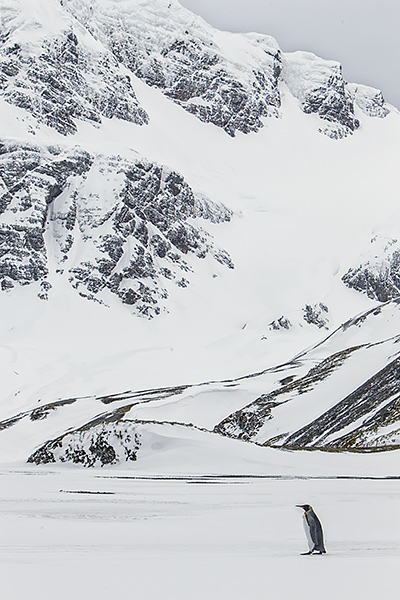
King Penguin walking in the snow against towering snow covered mountains, Right Whale Bay, South Georgia, Canon 1D MK4, Canon 70-200mm f2.8 lens @98mm, handheld, 1/320th sec, f10, ISO 640, manual exposure

Ice patterns over stones, Right Whale Bay, South Georgia, Canon 5D MK3, Canon 16-35mm f2.8 lens @35mm, handheld,1/125th sec, f13, ISO 400, manual exposure
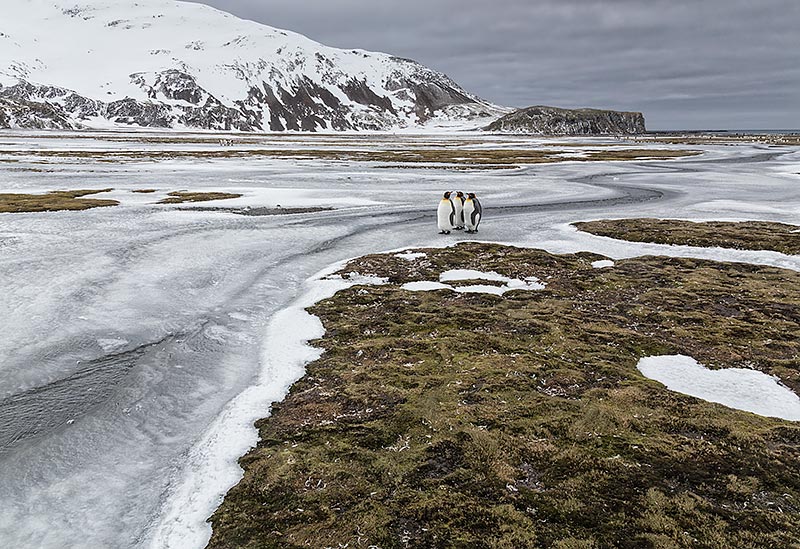
King Penguin group standing ice, Right Whale Bay, South Georgia, Canon 5D MK3, Canon 24-105mm f4 IS lens @24mm, handheld, 1/125th sec, f13, ISO 250, manual exposure
Back on the ship for lunch, we made a short repositioning to Prion Island. Here the main attractions are Wandering Albatrosses with juveniles on nests readily visible. A boardwalk was constructed that leads from the beach up to the nesting sites a few years ago. While this now makes the upward traverse quite simple, it does mean that your movements are restricted to the boardwalk, preventing the dramatic, close-up images of the birds with outstretched wings overlooking the sea and distant mountains, made famous by Frans Lanting.
However, back on the beach, I did manage to make this image of an adult male Elephant Seal (aka, the beach master) “cuddling” a female. As you can see, the size difference is quite extraordinary while the scarring on the male is the result of the endless battles he must fight to protect his harem of females from rival males.
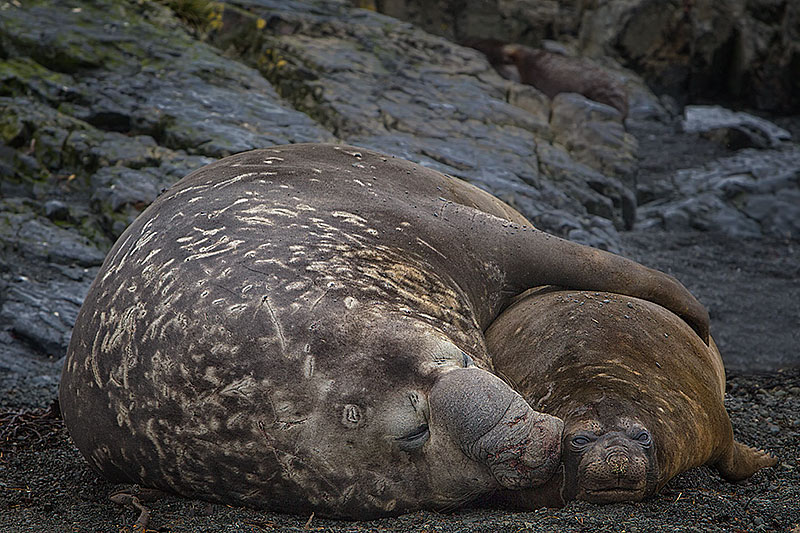
Male Elephant Seal embracing female, Prion Island, South Georgia, Canon 1D MK4, Canon 70-200mm f2.8 IS lens, @200mm, handheld, 1/640th sec, f7.1, ISO 640, manual exposure
The next morning we found ourselves further down the north east coast, at Fortuna Bay, a beautiful glaciated valley fronted by a well-protected Bay. This was a productive site image wise for me last year. This year with snow covering much of the ground and overcast skies eliminating any harsh shadows, conditions were close to perfect for photography.
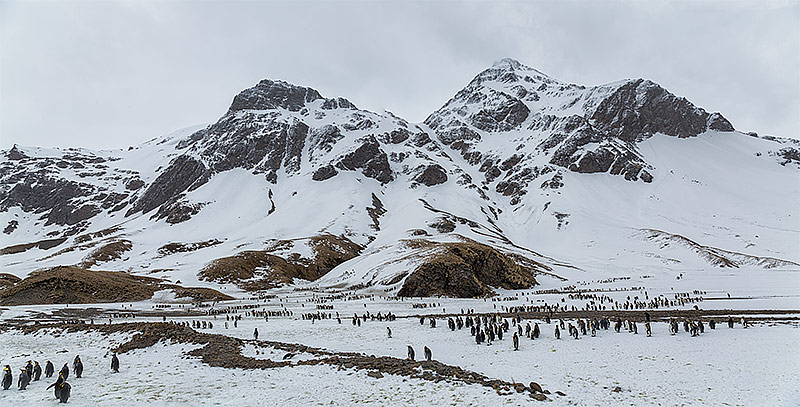
Panoramic view of Fortuna Bay (3 stitched images), 5D MK3, 24-105mm f4 IS lens @24mm, handheld, 1/250th sec, f11, manual exposure, South Georgia

King Penguin juxtoposed against two other King Penguins in the background, Fortuna Bay, South Georgia, Canon 1D MK4, Canon 600mm f4 IS 2 lens + 1.4x TC, Gitzo tripod, 1/500th sec, f10, ISO 500, manual exposure

King Penguin scratching its face with foot, Fortuna Bay, South Georgia, Canon 1D MK4, Canon 600mm f4 IS 2 l lens, 1.4x Canon TC, Gitzo tripod, 1/640th sec, f10, ISO 640, manual exposure
At one end of the site there is an open plain adjacent to a glacier below which lies a large King Penguin colony, populated at this time of the year by sizeable numbers of “Oakum boys”, the nickname given to the fluffy brown, juvenile King Penguins. As they huddled together for warmth, adult Kings would occasional venture into the group to seek out and feed their youngsters. I had previsualised the second image shown here, with the colorful splash of the adult’s head and neck feathers contrasting with the uniform browns of the juveniles.
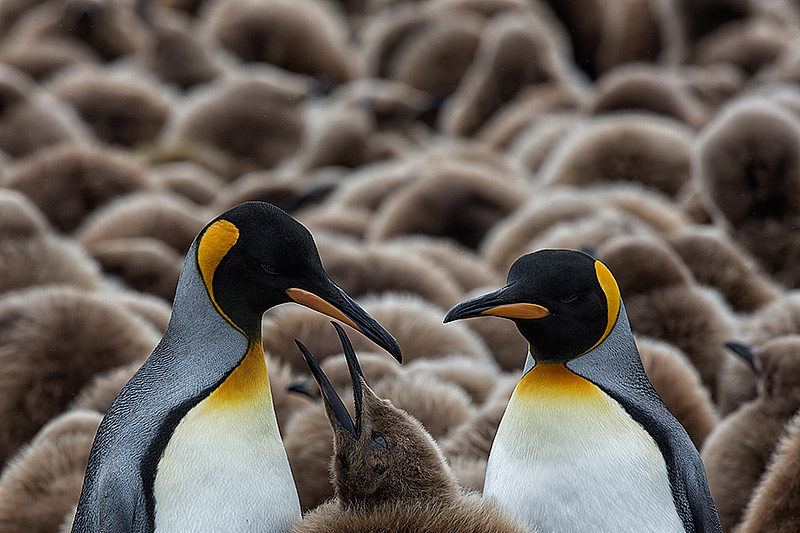
King Penguin chick begging for food from two adults, Fortuna Bay, South Georgia, Canon 5D MK3, Canon 600mm f4 IS 2 lens, Gitzo tripod, 1/400th sec, f13, ISO 800, manual exposure
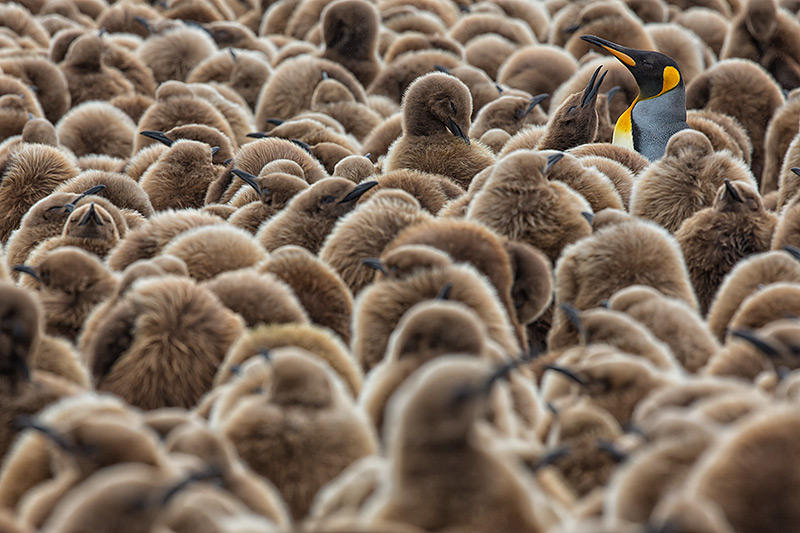
Adult King Penguin surrounded by chicks, Fortuna Bay, South Georgia, Canon 5D MK3, Canon 600mm f4 IS 2 lens, Gitzo tripod, 1/250th sec, f11, ISO 500, manual exposure
After some early morning zodiac cruising around Ocean Harbor (in reality a sizeable bay), on one side of which sits the wreck of the iron hulled three-masted barque, Bayard, now home to a colony of some 80 South Georgia Shags, we moved down the coast to Cumberland Bay to anchor at Grytviken, the largest of South Georgia’s ancient whaling stations and home to the Island’s only few inhabitants. Much of the old whaling station is open to visitors and like last year, I took some funky HDR images. The new Canon pro bodies, the 1DX and 5D MK 3 feature both in-camera HDR as well as multiple frame exposure capabilities. A big thanks to Denise Ippolito for showing me how to work these (as it turns out, they are extremely simple to use). The following image is a three frame, in-camera image of rusting paint on an old ship with the camera being moved horizontally, vertically and then diagonally during each of the respective frames. Pretty cool eh?

Peeling paint, three in-camera exposures, Gretviken, South Georgia, Canon 5D MK3, Canon 24-105mm f4 IS lens @105mm, handheld, 1/2nd, f22, ISO 100, manual exposure
Those of you who have read my blog from last year’s South Georgia trip will know the reverence that most attach to Saint Andrews Bay, which is often regarded as the jewel in South Georgia’s crown. It is unquestionably one of our planet’s truly great wildlife sites, being home to the world’s largest King Penguin colony where up to 160,000 adult pairs gather with at least an additional 50,000 juveniles. It is also home to South Georgia’s largest breeding population of Elephant Seals with our arrival being timed to coincide with peak breeding numbers of 6,000. So thick was the beach and shoreline with these blubbery, submarine sized creatures that passage across large sections of the beach was impossible. But it is not just the animals, it is also the setting. The following stitched panoramic image only does a tiny amount of justice (and the small jpg is doing no favours either) to the incredible vista that lies spread out in front of you once you have climbed a small ridge set back a little distance from the beach.

Panoramic view of King Penguin colony at Saint Andrews Bay, South Georgia (5 stitched images), Canon 5D MK3, Canon 24-105mm f4 lens @28mm, handheld, 1/400th sec, f13, ISO 500, manual exposure
This image was taken in the middle of the day when the sun had long disappeared to be replaced by low hanging cloud and intermittent sleet. But early in the morning when I first landed, a low sun was out, the air was crisp and clear and a throng of Kings came down to the water’s edge to greet us. The last image in this series featured a moment of serendipity with a large flock of Shags flying towards and over me.
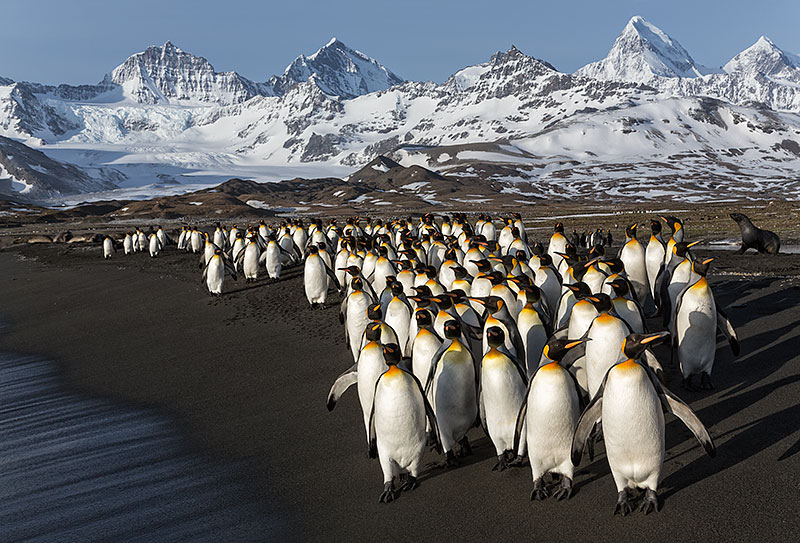
King Penguins on the shore line of Saint Andrews Bay, South Georgia, Canon 5D MK3, Canon 24-105mm f4 IS lens @47mm, handheld, 1/640th sec, f16, ISO 400, manual exposure
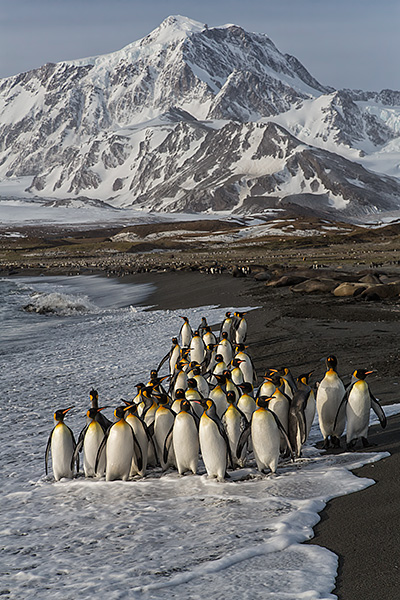
King Penguins standing on beach in shore surf, Saint Andrews Bay, South Georgia, Canon 5D MK3, Canon 24-105mm f4 IS lens @73mm, 1/320th sec, f11, ISO 500, manual exposure

King Penguin group headed out to sea, wide-angle, Saint Andrews Bay, South Georgia, Canon 5D MK3, Canon 24-105mm f4 IS lens @70mm, handheld, 1/320th sec, f11, ISO, manual exposure

Elephant Seal and King Penguins on the shore line with Imperial Shags flying in the sky, Saint Andrews Bay, South Georgia, same equipment as previous, 1/125th sec, f13, ISO 400, manual exposure
At midday I was up on the ridge that overlooks the bay. Before taking the earlier panoramic image, we had two adult Kings standing nicely on the ridge line overlooking the colony of Oakum boys and adults. I was sitting down a few feet from these two when two more adults walked into the frame.
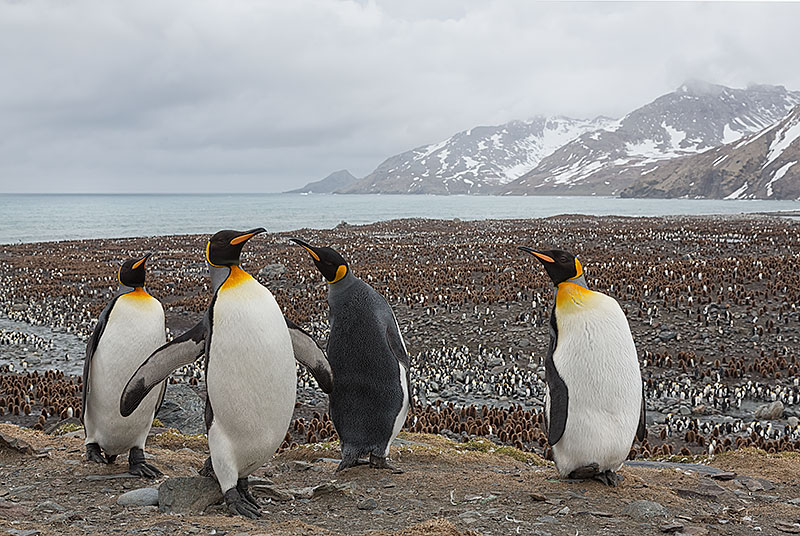
King Penguins on a ridge overlooking thousands of adult and juvenile King Penguins, Saint Andrews Bay, South Georgia, Canon 5D MK3, Canon 24-105mm F4 IS lens @50mm, handheld, 1/125th sec, f11, ISO 500, manual exposure
I then moved a little further down the ridge to where a some of the juvenile Oakum boys were interacting with adults. I needed to keep some distance from the birds so as not to disturb them. At the same time, the juveniles would harass their parents for food and hence both parent and offspring were in a constant state of motion. In these situations, a tripod just slows you down so this next image was made with the new Canon 600mm lens resting on my knee.

King Penguin chick begging for food from adult, Saint Andrews Bay, Canon 1D MK4, Canon 600mm f4 IS 2 lens, handheld resting on knee, 1/1,000 sec, f7.1, ISO 400, manual exposure
I was told by one of my fellow travelers that a long way back from the beach on one side of the bay, were a series of glacial melt lakes on which one could sometimes find Penguins. So I walked for 30-40 minutes until I reached the lakes only to find there were no Penguins near the water. However, there were several Antarctic Skuas, all engaged in vigorous bathing activity. The birds would duck their heads under the water at high speed, pause and then rise up in the water to flap their wings.
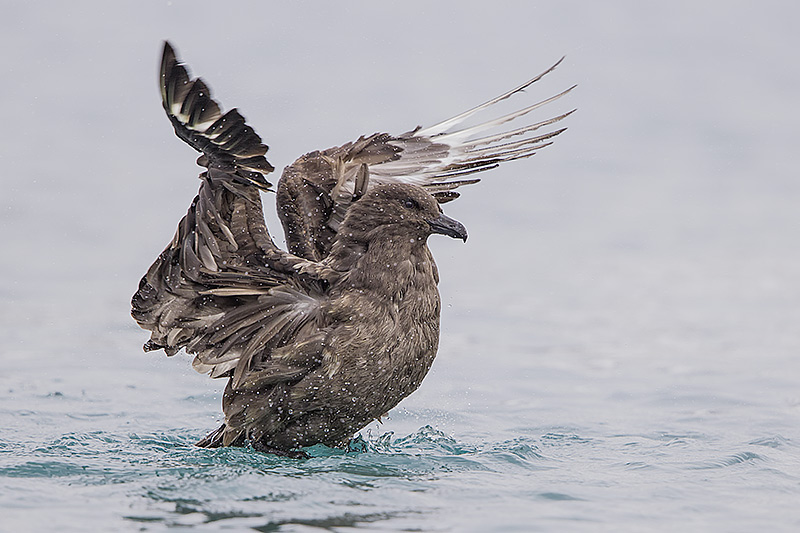
Antarctic Skua bathing, flapping wings, glacial melt lake, Saint Andrews Bay, Canon 1D MK4, Canon 600mm f4 IS lens, 1.4x TC, Gitzo tripod, 1/2,000 sec, f5.6, manual exposure
Later on while I was down towards the beach photographing a large group of King Penguins huddled together, I had another go at shooting multiple in-camera frames, again moving the camera a little for each image.

King Penguins, multiple exposures, Salisbury Plain, South Georgia, Canon 5D MK3, Canon 600mm f4 IS lens + 1.4x TC, Gitzo tripod, 1/ 5th sec, f45, ISO 100, manual exposure
Back on the beach, the sheer density of Elephant Seals made movement difficult but I wasn’t the only one whose progress was being impeded by these goliaths. King Penguins returning from sea would often find their route back to the colony and their youngsters blocked and would have to gingerly pick their way through the seals, often being forced to make major detours. The breaking wave and spray are what makes this next image really work.

King Penguin walking between Elephant Seals with breaking wave spray in the background, St Andrews Bay, South Georgia, Canon 1D MK4, Canon 600mm f4 IS 2 lens, Gitzo tripod, 1/400th sec, f13, ISO 400, manual exposure
Another fabulous day came to an abrupt end when the captain of our ship deemed that the swell around the bay was getting to the point of making boarding the ship from the zodiacs dangerous.
Overnight we sailed further south to the southeast corner of the island and into the spectacular Drygalski fjord. Later we made a short zodiac cruise in Larsen harbor. The following image was made as we were cruising out of the fjord.
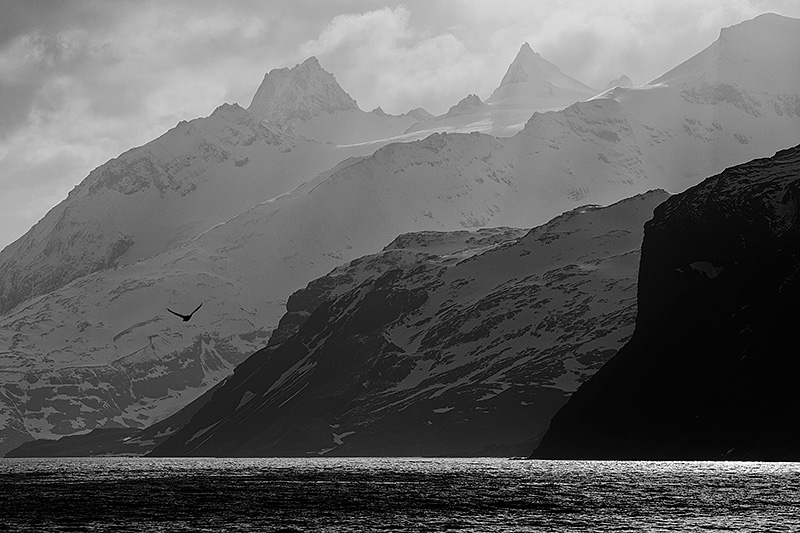
Imperial Shag silhouetted against snow capped mountains by sea, Drygalski Fjord, South Georgia, Canon 1D MK4, Canon 70-200mm f2.8 IS lens @160mm, handheld, 1/640th sec, f11, ISO 200, manual exposure
From there we rounded Cape Disappointment and proceeded up the south west coast of South Georgia. Few vessels venture to this side of the island, being much more exposed to the prevailing winds, but the scenery is wild and spectacular. Our ship was again trailed by large numbers of birds. Here, two Light Mantled Sooty Albatrosses glide alongside the ship as high winds whip by. Foreboding though the weather conditions may seem, these are perfect conditions for Albatrosses which spend most of their lives on the wing out at sea.

Two Light Mantled Sooty Albatrosses flying over stormy seas with the south west coast of South Georgia in the background, Canon 1D MK4, Canon 300mm f2.8 IS lens, handheld, 1,1250th sec, f8, manual exposure
We had hoped to make one or two landings on the west side of the island but unfavourable weather conditions made this impossible. Instead, having circumnavigated the island, we continued along the north coast to one of South Georgia’s gems, Salisbury Plain. Rather than going straight to the main bay, we went first to one of the smaller bays, Salisbury Plain Ample Bay. After a short hike up from the beach, we emerged onto a snow covered plateau surrounded by mountains with decent numbers of King Penguins and female Elephant seals.
At some point during mid-morning, the weather closed in and it began to snow, with brief blizzard like conditions. The King Penguin groups huddled together, facing away from the snow flurries.
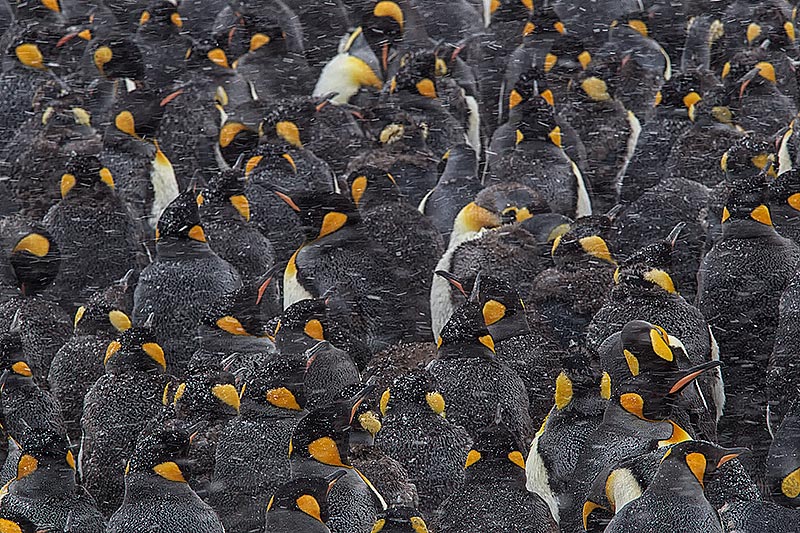
King Penguin colony during snow storm, Sailsbury Plain Ample Bay, South Georgia, Canon 1D MK4, Canon 300mm f2.8 IS lens +1.4x TC, handheld, 1/200th sec, f16, ISO 500, manual exposure
Towards the end of the landing, I spent nearly an hour with a group of extremely playful female Cape Fur Seals. Making the following image of two females rising up in the air before coming together was not easy as a great deal of persistence was needed to get just one image where their bodies and head were both symmetrical and parallel to my camera.

Fur Seal females playing, Salisbury Plain, Ample Bay, South Georgia, Canon 5D MK3, Canon 300mm f2.8 lens, 1.4x TC, handheld, 1,1000 sec, f8, ISO 640, manual exposure
Over lunch the ship made a short repositioning to the more well known, Salisbury Plain, landing site. This is is home to 60,000 breeding pairs of King Penguins, huge numbers of juvenile Kings and one of the largest Elephant Seal populations on South Georgia. I spent most of my time on the beach, initially focusing on tight, close-up images of the colouration on the heads and neck of adult King Penguins…

King Penguin head and neck patterns, Sailsbury Plain, South Georgia, Canon 1D MK4, Canon 300mm f2.8 IS lens + 1.4x TC, handheld, 1/320th sec, f14, ISO 1,250, manual exposure
…before moving on to close-focus, wide-angle images of the Penguins, Elephant Seals and Cape Fur Seals. In these images, an angle finder proved invaluable. This is a small, vertical view finder that attaches to the camera’s own view finder which allows you to get the camera and lens right down on the ground but without killing your neck in the process.
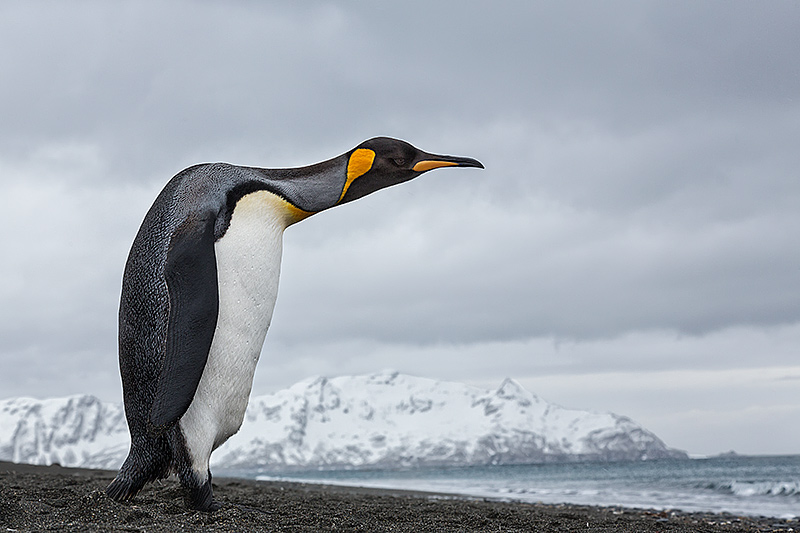
Close-focus, wide-angle image of King Penguin peering out to sea from beach, Salisbury Plain, South Georgia, Canon 5D MK3, Canon 24-105mm f4 IS lens @65mm, camera and lens resting on beach, Canon angle finder, 1/320th sec, f14, ISO 400, manual exposure

King Penguins walking past Elephant Seal, Salisbury Plain, South Georgia, Canon 5D MK3, Canon 24-105mm f4 IS lens @70mm, Canon angle finder, camera and lens resting on ground, 1/400th sec, f13, ISO 640, manual exposure

Male and female Fur Seal interacting on the beach, Salisbury Plain, South Georgia, Canon 5D MK3, Canon 24-105mm lens @ 88mm, Canon angle finder, camera resting and lens on ground, manual exposure, 1,320th sec, f13, ISO 800
Overnight we sailed down the coast, repositioning at Cooper Bay which is often an elusive site due to aggressive Fur Seals and high swells at the beach landing site. The main attraction here is a colony of Macaroni Penguins, viewable among the tussock grass but only after a steep hike up from the beach. Normally this involves scrambling up a muddy cliff but when we awoke in the morning, heavy snow had fallen overnight and continued to fall throughout the duration of the landing.
While there were some good opportunities with the Macaronis as shown here with this one calling in the snow, I spent much of my time concentrating on other avian species.

Macaroni Penguin in the snow, calling, Cooper Bay, South Georgia, Canon 1D MK4, Canon 300mm f2.8 IS lens + 1.4x TC, handheld, 1/500th sec, f10, ISO 640, manual exposure
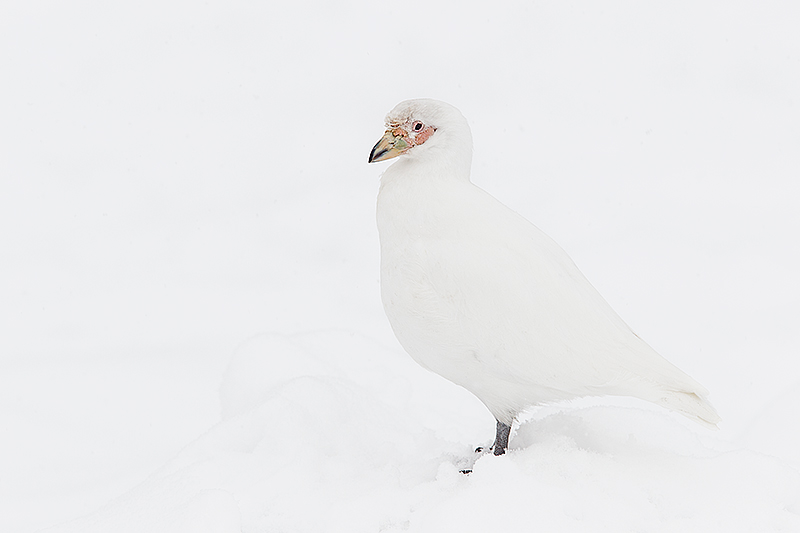
Snowy Sheathbill standing in the snow, Cooper Bay, South Georgia, Canon 1D MK4, Canon 300mm f2.8 IS lens + 1.4x TC, 1/ 640th sec, f6.3, ISO 500, manual exposure

Snowy Sheathbill flying in snowstorm, with motion, Cooper Bay, South Georgia, Canon 1D MK4, Canon 300mm f2.8 lens, 1.4x TC, handheld, 1/200th sec, f6.3, ISO 160, manual exposure
In the above image I deliberately chose a relatively slow shutter speed to ensure some motion would be visible in the wings while also allowing for some streaking of the falling snow flakes. In the following image I switched back to a faster shutter speed as the Albatrosses rarely flap their wings, instead relying on their supreme gliding capabilities.
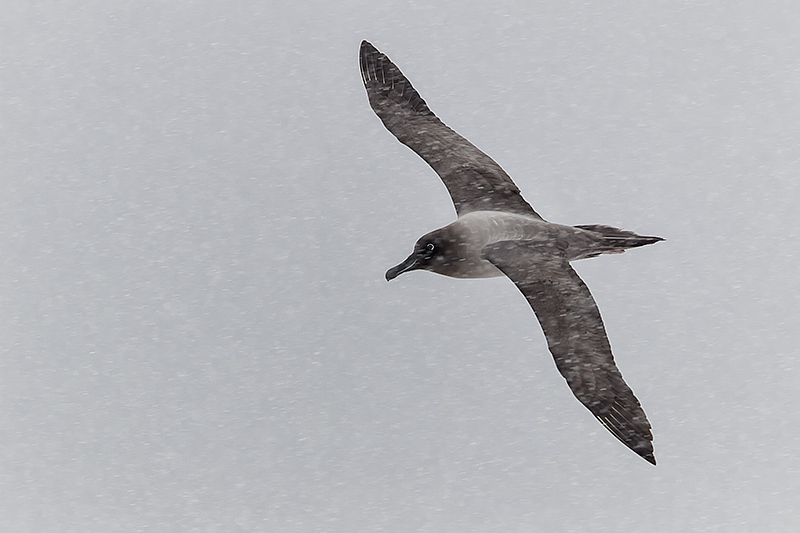
Light Mantled Sooty Albatross flying through falling snow, Cooper Bay, South Georgia, Canon 1D MK4, Canon 300mm f2.8 lens + 1.4x TC, handheld, 1/800th sec, f8, ISO 500, manual exposure
Towards the end of the landing, we had a lot of fun with waves of Gentoo Penguins returning from fishing trips out at sea which then had to make their way up steep, snow covered slopes to get back to their colonies. In this next image, the prime attraction is the raised orange foot.
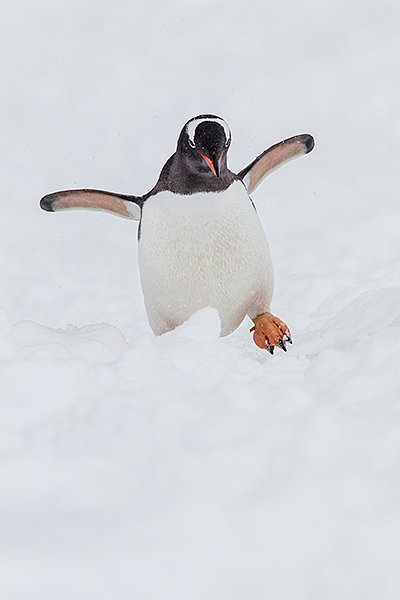
Gentoo Penguin walking through the snow with raised foot, Cooper Bay, South Georgia, Canon 1D MK4, Canon 300mm f2.8 IS lens + 1.4x TC, handheld, 1/800th sec, f8, ISO 500, manual exposure
Back on the ship, we made the short sail to Gold Harbour. When we landed, we found the beach thick with Elephant Seals which although restricting our movements, provided plenty of photographic opportunities. As rain and sleet fell, steam rose up from the seals, amplifying the already misty conditions. Once again, I was particularly attracted to the difficulties that the Penguins, in this case Gentoos, were having in trying to thread their way through the near impassable blockade created by the densely packed Seals.
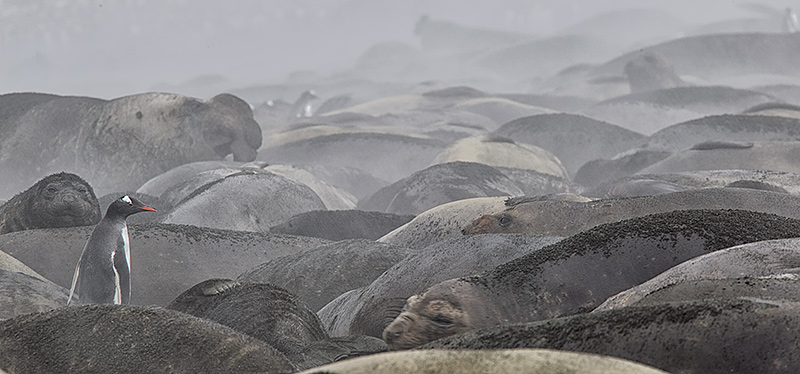
Gentoo Penguin standing in Elephant Seal colony, Gold Harbour, South Georgia, Canon 1D MK4, Canon 300mm f2.8 IS lens +1.4x TC, Gitzo tripod, 1/30th sec, f14, ISO 200, manual exposure
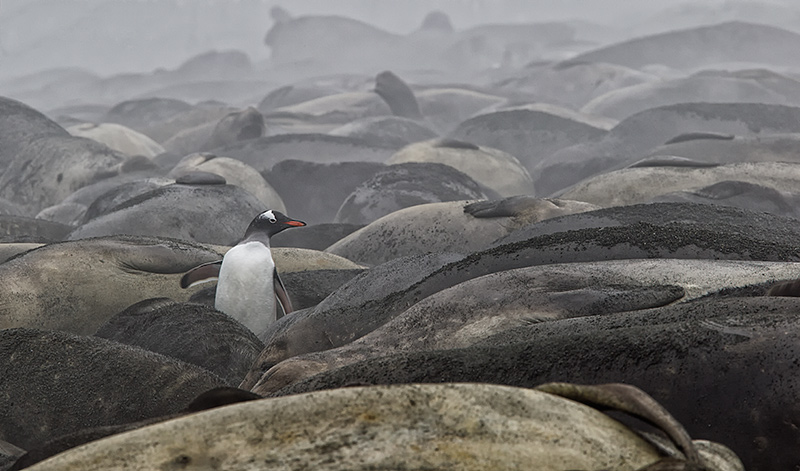
Gentoo Penguin standing in giant colony of Elephant Seals, Gold Harbour, South Georgia, Canon 1D MK4, Canon 300mm f2.8 IS lens + 1.4x TC, Gitzo tripod, 1/ 30th sec, f16, ISO 200, manual exposure
Later we had opportunities with the Gentoos as they surfed in on the waves to the beach. This is not as easy as it looks as the Penguins remain submerged below the waves until the very last second making tracking them through a long lens extremely difficult.

Gentoo Penguin surfing through the shore break, Gold Harbour, South Georgia, Canon 1D MK4, Canon 600mm f4 IS 2 lens, handheld, resting on knee, 1/1,250th sec, f5.6, ISO 1250, manual exposure
Overnight we sailed all the way back to the top of the island for a planned landing at Godthul. I boarded the zodiac in heavy rain, which had intensified even further by the time I landed. I stood on the beach for about a minute, quickly deducing that the wildlife opportunities appeared limited while I didn’t want to give my already soaked camera gear another drenching. So I hopped back on the zodiac and went straight back to the ship.
In the afternoon, we had time for one last landing on South Georgia, again at Right Whale Bay. Even in the space of two weeks, large portions of the snow and ice which we had earlier encountered at this site had melted, reducing the scenic attractiveness. I again made good use of the angle finder to produce this image of a group of extremely curious King Penguins. So curious were they that I regularly had to back up to include all of them in the frame.
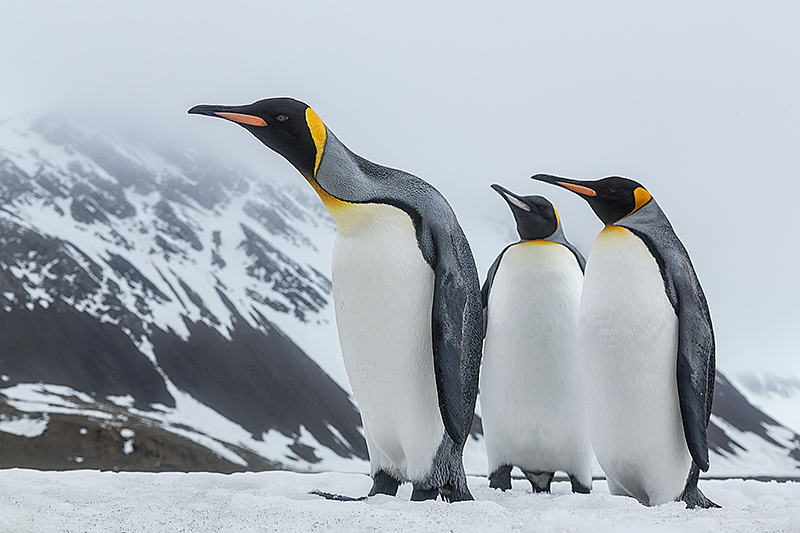
Close-focus, wide-angle image of King Penguins on the snow at Right Whale Bay, South Georgia, Canon 5D MK3, Canon 24-105mm f4 lens @ 70mm, Canon angle finder, 1/160th sec, f.11, ISO 500, manual exposure
Once back on the ship, we immediately set sail for the Falkland Islands. By southern Ocean standards, conditions during the 3.5 day crossing were relatively benign. On the morning of the fourth day we found ourselves anchored in the sheltered confines of a wide bay at Sealion Island in the southern Falklands.
There is a large variety of wildlife on Sealion Island but probably most prized is the large colony of Rockhopper Penguins. The problem is that to reach them requires a 6km hike either way, much of it uphill on the way there. Without a large assortment of heavy camera equipment to carry, this would be a comfortable stroll but weighed down as I was, the last parts of each “walk” were quite strenuous. As it turned out, I didn’t make any images of Rockhoppers that I really liked and ended up spending more time with the Striated Caracaras, the closest equivalent to the Vultures of the plains of East Africa.
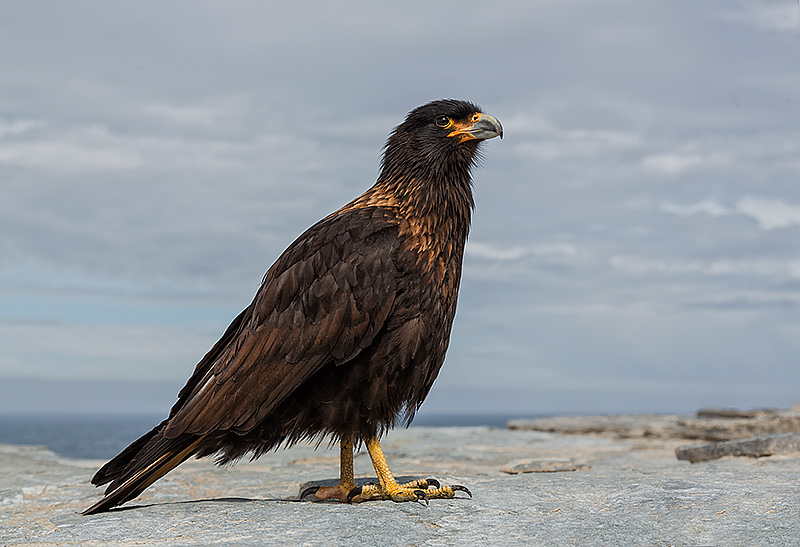
Striated Caracara on sea cliff edge, Sealion Island, Falkland Islands, Canon 1D MK4, Canon 24-105 f4 IS lens @65mm, lens and camera resting on ground, angle finder,1/1,000th sec, f9, ISO 400, manual exposure
Later on I focused on several smaller bird species on an inland lake including this Two Banded Plover.

Two banded Plover on lake, eye level, Sealion Island, Falkland Islands, 1D MK4, Canon 600mm f4 IS lens +1.4x TC, lens resting on muddy lake shore, 1/2,500 sec, f7.1, ISO 400, manual exposure
Before we reboarded the ship we were able to have another go at surfing Gentoo Penguins. This time I tried for something different, slowing the shutter speed right down to capture the motion of the breaking surf with a splash of colour provided by the Gentoo’s colourful bill.

Gentoo Penguin beneath breaking wave, with motion, Sealion Island, Falkland Islands, Canon 1D MK4, Canon 70-200mm f2.8 IS lens + 1.4x TC at 280mm, handheld, 1/ 15th sec, f18, ISO 50, manual exposure
One of the main reasons I signed up for this trip so long ago was the inclusion of a full day landing on remote Steeple Jason Island, located on the extreme north west of the Falkland Islands and part of the Jason Island group. With its twin pinnacles, it is a dramatic island and fully exposed to the elements. While the environment is hostile to man, the high winds that slam into the island make it a perfect destination for Albatrosses and it is no coincidence that it is the largest breeding ground for Black-Browed Albatrosses with 220,000 breeding pairs along its three miles of coastline.
To reach the birds is no easy task with a steep hike up from a rocky landing site before one is greeted by head high tussock grass, often unsurpassable. The density of birds, most of them sitting on mud-sculptured nests, is incredible and is accompanied by a wall of shrill like whistles, grunts and screams overlain with distinctive bill clapping.
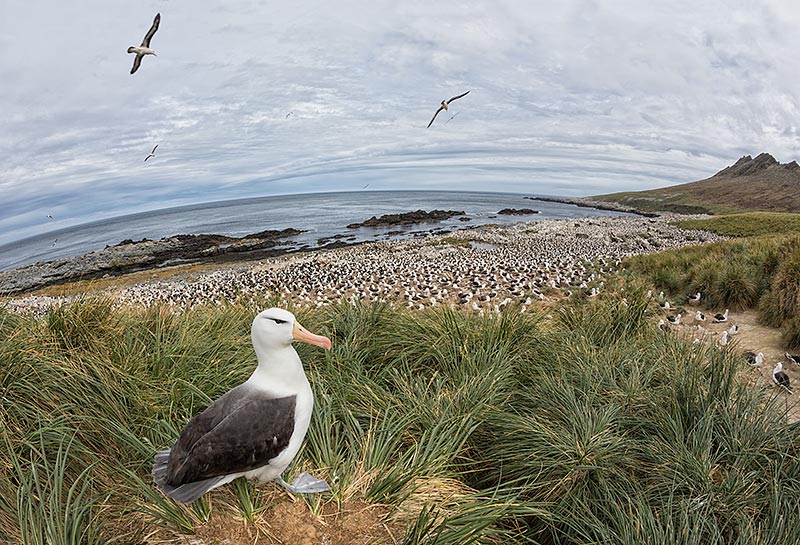
Fish-eye view of Black-Browed Albatross overlooking Albatross colony, Steeple Jason Island, Falkland Islands, Canon 5D MK3, Canon 15mm f2.8 fisheye lens, handheld, 1/400th sec, f13, ISO 400, manual exposure
The Black-Browed Albatrosses are beautiful birds with a cover girl appearance – their feathers appear almost air-brushed, their eyes and brows seemingly the work of a make-up artist and their flesh coloured bills tapering to a gorgeous reddish hue at the tip.

Black-Browed Albatross face portrait, Steeple Jason Island, Falkland Islands, Canon 1D MK4, Canon 300mm f2.8, IS lens + 1.4x TC, handheld, 1/400th sec, f14, ISO 640, manual exposure
In the early afternoon it began to pour with rain. This sent the nesting birds into a frenzy of activity as they took advantage of the more pliable mud to shore up and further sculpt their nests. It also provided opportunities for more in-camera multiple exposures.

Black Browed Albatross colony blur, Steeple Jason Island, Falkland Islands, Canon 5D MK3, Canon 24-105mm lens @ 105mm, handheld, 5 in-camera exposures, manual exposure, 1/60 sec, f.13, ISO 400
Dotted around the colony were the ubiquitous Caracaras, on the lookout for exposed Albatross eggs and once these hatch, for unattended chicks. Despite their unappealing scavenging tactics, it was hard not to feel just a little sympathy as they shivered in the falling rain.

Striated Caracara in the rain, Steeple Jason Island, Falkland Islands, Canon 1D MK4, Canon 300mm f2.8 IS lens + 1.4x TC, 1/125th sec, f 7.1, ISO 250, manual exposure, Canon 550 EX flash (-1), better beamer
While my Gortex clothing did a decent job of keeping me dry, my thin gloves were thoroughly soaked and my hands grew increasingly cold and numb. By mid-afternoon it was time to call it a day and so I headed back to the ship, a hot shower beckoning. Before that though, there were some good opportunities with Giant Petrels around the ship as they took off and landed on the ocean surface. In this image, I again made use of a slowish shutter speed – fast enough to keep the head sharp but slow enough to blur the bird’s pumping feet.

Giant Petrel taking off from ocean surface, Steeple Jason Island, Falkland Islands, Canon 1D MK4, Canon 300mm f2.8 IS lens, handheld, 1/125th sec, f16, ISO 200, manual exposure
For our last day in the Falklands, we sailed down to New Island in the western Falklands. We started off at the north side of the island where a Black-Browed Albatross colony is perched on a dramatic cliffed landscape a half mile from the landing site. There was plenty of opportunities for images of the Albatrosses interacting with each other although getting decent head angles was much more challanging.
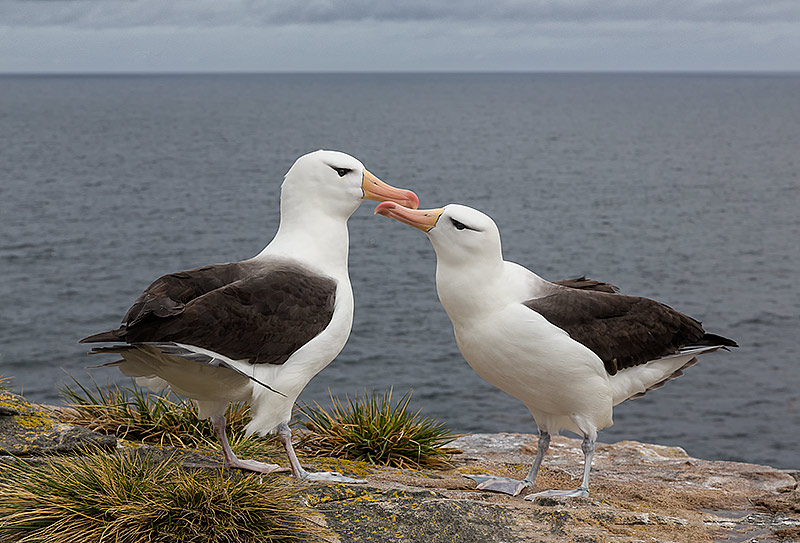
Two adult Black-Browed Albatrosses on the edge of a cliff, overlooking sea, courting, New Island, Falkland Islands, Canon 5D MK3, Canon 24-105m f4 IS lens @82mm, handheld, 1/640th sec, f11, ISO 500, manual exposure

Black-Browed Albtrosses courting, New Island, Falkland Islands, Canon 1D MK4, Canon 600mm f4 IS 2 lens, handheld, manual exposure, 1/640th sec, f9, ISO 500
The distant blue ocean made a beautiful backdrop for tight, intimate portraits of the Albatrosses.
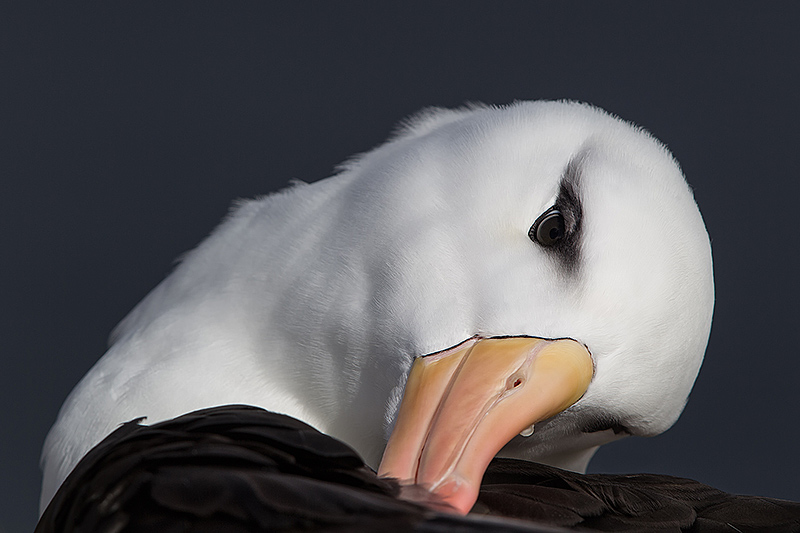
Black-Browed Albatross preening, New Island, Falkland Islands, Canon 1D MK4, Canon 600mm f4 IS lens + 1.4x TC, Gitzo tripod, 1/800th sec, f10, ISO160, manual exposure
At midday we made a 20 minute zodiac ride across a wide bay to South Harbour and the nearby Settlement Rookery. We again encountered Black-Browed Albatrosses along the cliffs as well as Rockhopper Penguins but the main attraction was the endless streams of inbound Imperial Shags in flight carrying nesting material in their bills.

Imperial Shag flying, carrying kelp to be used as nesting material, New Island, Falkland Islands, Canon 5D MK3, Canon 300mm f2.8 IS lens, handheld, 1/2,000 sec, f7.1, ISO 500, manual exposure
Back on the ship we immediately set sail for Ushuaia at the very southern end of Argentina, in order to beat a fast approaching storm. Although the last 24 hours saw us encounter gale force winds and huge seas, the passage felt relatively smooth with the ship facing almost directly into the wind and waves thereby avoiding any severe rolling motion. Not far from the entrance to the shelter of the Beagle Channel, we encountered a fishing vessel surrounded by what seemed like hundreds, possibly even thousands of sea birds. As we sailed by they switched their attention to us and for the next hour or two we had a huge procession of birds flying behind the stern of the ship. I again tried for something a little different photographic wise, shooting at just 1/20th of a second. Somehow, I managed to get the ocean relatively sharp while capturing the motion of the birds. With the scence almost monochromatic, a black & white conversion was an obvious choice.
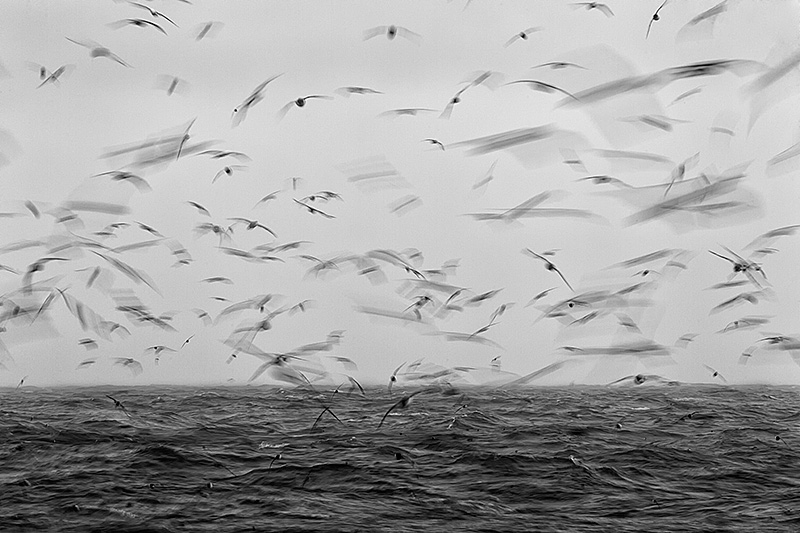
Cape Petrels, Giant Petrels and Albatrosses flying blur, Scotia Sea, Southern Ocean, Canon 1D MK4, Canon 300mm f2.8 IS lens, handheld, 1/ 20th sec, f.13, manual exposure, ISO 100
A few hours after this image was taken we entered the calmer waters of the Beagle Channel from where we made our way to the port of Ushuaia, disembarking the next morning. All in all it had been a tremendous trip; one that will forever remain lodged in my memory. I made a number of good friends on the trip and the ship’s crew and expedition staff were exemplary. While it may be a few more years before I return to the wonders of the Southern Ocean, this is a destination that will surely pull me back again.
Clemens Vanderwerf
December 13, 2012
Great story and images Paul. Some great and different angles! Brings back a lot of memories from an excellent trip. Looking forward to photograph again with you in the near future. All the best, Clemens.
Paul Mckenzie
December 14, 2012
Thx Clemens, I still really like your fish-eye images on Steeple Jason. Look forward to seeing your Antarctic photos.
Wayne Sentman
December 14, 2012
Hello Paul, Wonderful set of images, especially like the lone penguin in the elephant seal rookery and the albatross colony “blur”. I am just back from another amazing trip to Raja Ampat and Sulawesi, but I am envious of the ground you have covered in that time. Hope to see you again, unfortunately it does not look like that will be on Midway this year. Thanks for sharing your techniques and images in these inspiring posts.
Paul Mckenzie
December 14, 2012
Hi Wayne, I was signed up for a Midway trip in March so am super disappointed that it is now shut to visitors. Supposedly the cut-backs that have made it off limit, relate to the lay off of 2 staff members. Unbelievable!
Arthur Morris
December 14, 2012
Seeing the vision of a wonderfully creative photographer who I was traveling with is completely inspiring. Thanks for sharing and for your kind words. artie
Paul Mckenzie
December 14, 2012
Thx Artie. As usual these images would not have been possible without your printed and online publications. Will send you an email soon with an update on Japan.
Gordon Lindsay
December 14, 2012
Terrific images Paul and I thoroughly enjoyed your narrative, I look forward to reading about your adventures on the rest of your trip.
Alas I’m too old and it’s too cold for me down there.
Best regards
Gordon
Sandy
December 14, 2012
Fabulous! I always look so forward to your photo journals. You have an exceptional eye to accompany your wonderfully adventurous spirit. Thank you for sharing 🙂
JAMES MENJO
December 14, 2012
Paul, the are very interesting. I would like to be there. Keep it up.
Paul Mckenzie
December 14, 2012
Thanks James, am trying to fix a trip to Mexico sometime in the next 12-18 months. Will keep you posted.
John Wall
December 14, 2012
Such a beautiful story and jaw-dropping images. Thanks so much for sharing.
Susie
December 14, 2012
Great photos Paul! Love the one that shows the size of the elephant seal next to the penguins. Makes me feel like I’m right there! Except I’m in much warmer NorCal. =)
Luc Ongena
December 14, 2012
I love the bad weather pictures ! very well done
Luc
Osvaldo Larrain L.
December 14, 2012
Excelente work Paul , it was a great pleasure to meat you , and you have your home in Santiago , Chile when you need it . All the best, Osvaldo.
Paul Mckenzie
December 14, 2012
Thanks so much for all your hospitality in Santiago. It was really appreciated. Artie, Denise, Clemens and I will always be in your debt. Am sure we will see you again.
Richard Vernick
December 14, 2012
Paul,
Awe inspiring as usual. Barbra and I look forward to going back to the Falklands and South Georgia. She just got the 5D Mark iii Xmas present and is anxious to exercise it. Hope your and your wife and child are doing well.
Richie
Paul Mckenzie
December 14, 2012
Thanks Richie, all good here. You definitely should try out the HDR amd multiple frame capabilities in the 5D MK3. Take care, Paul
Jaime Migoya
December 14, 2012
Paul. Your photographas are amazing. I really like your mulple exposures on the same frame. I hope to join you again in another trip, preferably to South Georgia, my favorite place for wildlife.
Jaime
Paul Mckenzie
December 14, 2012
Am trying to plan a trip to Mexico. Will keep you posted on my plans.
Rodolfo Patron
December 14, 2012
Wooow again fantastic and great pictures! I felt nostalgic for being there, already one year ago!!
Rodolfo
Paul Quah
December 14, 2012
As I read this, I feel like I’m actually there …with my fingers hurting from the cold! Great images and variety as usual!
Robert Pickard
December 14, 2012
Hi Paul
Your images are just getting better and better! Well done and thank you for making them available for me to view! Robert
denise ippolito
December 14, 2012
Paul, This is a wonderful trip report, I was hanging on every word. I really like your Albatross close-up and the rust multiple but all of the images are terrific! Great eye for the ice pattern image also. I am looking forward to Japan!
Alan Lillich
December 15, 2012
Paul,
Thanks for the inspiring trip report! I agree about the storm petrel against blurred water. I can feel the bird zooming past, vastly better than the couple of sharp high shutter speed shots of them that I got. My second favorite (very hard to decide), is the five image albatross blur from Steeple Jason – I especially like the ghostly sharp birds.
Alan
Terry Jackson
December 15, 2012
Paul
Thanks for sharing, Really enjoyed the shots and the explanations.
I went with Lindblad last year so your shots were a great reminder of a trip of a life time. We were unable to get into St. Andrews Bay because of heavy fog – but did spend a marvelous 6 hours at Salisbury Plain.
Cheers and Happy Holidays
Terry Jackson
Steve Sage
December 17, 2012
Paul,
Thanks for sharing another collection of outstanding, creative and insightful images. Your work is truly inspiring! I really hope I can visit these incredible places again.
persefoni
December 18, 2012
God, your shots are stunning! Congratulations indeed!
persefoni
December 18, 2012
Dear Paul, may i ask if the lens of 600 mm is necessary over there? I am planning to purchse the 400 m f2.8, but do you think i should rather take the 600mm for my antartica trip next year?
also instead of the 16-35 mm i am got the 11-24 mm – what do you think?
what was the temperature like in Novermber?
Is gorexex clothing a must over there or other waterproof cloths would do?
many thanks
Paul Mckenzie
December 18, 2012
600mm not necessary. 400mm f2.8 will easily get the job done as long as you have teleconverters as well (1.4x and 2x).300mm f2.8 with TCs also fine. Ideally you want a lens that has good length but which you can also handhold for reasonable periods of time. Worth also considering the Sigma 50-500mm f5.6-6.3 lens. This sounds like a joke lens but if you shoot at f8 or higher, the results are excellent. It’s very light and obviously incredibly versetile. A 12-24mm lens will definitely have some use but i would prefer something a bit longer and with a wider zoom range such as (for Canon shooters) the 24-105mm lens. Gortex is essential. In South Georgia in November you will have plenty of rain and you will also get wet on the zodiac landings. Waders or at a minimum, knee high waterproof boots are essential as all the landings are wet ones and the surf can be quite big at some of the landings. You also need a dry bag for your backpack to go into to keep it dry on the landings.
Graham Morgan
January 10, 2013
Paul I always enjoy your images and stories and this one was no different. Wonderful stuff. Looking at the wildlife through a 600mm lens is a different perspective to what is usually seen. The Black Brow closeups would melt your heart. I think they were my favourite images. We are just back from the NZ sub Antarctic islands and that is a trip that would interest you I’m sure.
Thanks again Paul but I have a question. How do you manage to carry such an arsenal of gear with you to these locations and did you take it all ashore at the same time in South Georgia? You must look like a pack horse from the Klondike in the airport!
We are getting ready to travel to Antarctica again travelling back from the peninsular all the way to the Ross Sea and on to Macquarie Island. This will be first time I’m not taking a tripod and a big lens. The ISO capabilities of the 5D and 1Dx allow me to maintain good shutter speeds and the longest lens I will have with me is a 400 DO.
All the best
Graham
Paul Mckenzie
January 17, 2013
Thx Graham. Yes carrying all that camera gear to remote locations is a big pain. My backpack weighs a tonne (although I’ve had surprisingly few hassles getting it onto planes) and I also use a huge photo vest. If I bring the 600mm and the 300mm, I’ll rarely take both onshore. One good thing is that the new 600 weighs less than the old monster.
Chris Marsham
May 22, 2013
Hi Paul – thought I had responded to your S Georgia blog some time ago – perhaps not. Great meeting up with you again. As always stunning results and a super blog. Was an amazing trip and your blog is as good as it gets and of course the images speak for themselves. Stunning as always. Pleased to say the few images from the trip that I have so far entered in national and international salons have been accepted, garnering a gold in our south west exhibition. Even though Lan Chile managed to dump my tripod and everything else at Punta Arenas, not all was lost! Hope you, your wife and son are all OK.
Paul Mckenzie
May 22, 2013
Hi Chris. Yes it was a fantastic trip and thank you for asking after my family. All good. Congratulations on your competition results.
Beryl McKenzie
April 5, 2016
Wonderful pictures Paul. These should be entered in competitions and especially the World Wildlife Book for 2016. Couldn’t get over the size of the huge Penguin Colony.